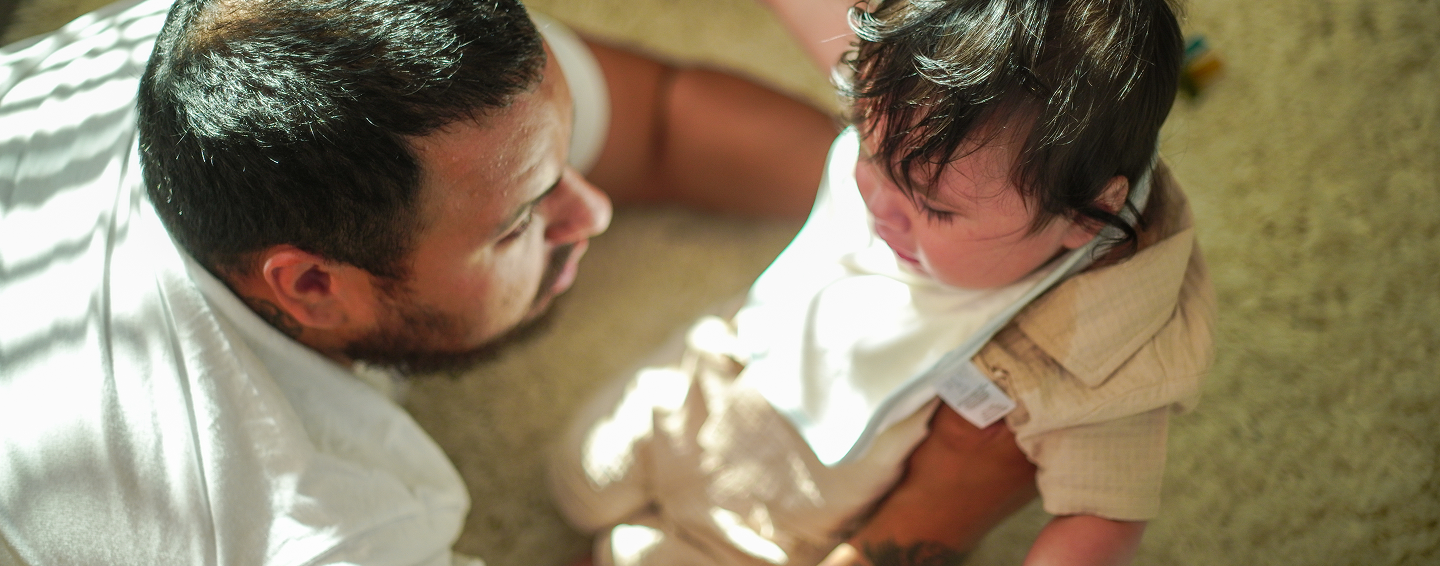Understanding 6 Month Old Night Feeding Patterns
6 month old night feeding is a turning point for most families. Your baby may still wake 1-2 times per night, but many are ready to start reducing these feeds as their digestive systems mature and they can go longer stretches without food.
Quick Answer for 6 Month Old Night Feeding:
- Normal: 1-2 night feeds (down from 3-4 in earlier months)
- Total daily intake: 22-28 oz of breast milk or formula
- Sleep stretches: 6-8 hours possible for babies 12-13+ pounds
- Breastfed babies: Often need night feeds until 12 months
- Formula-fed babies: May drop night feeds around 6 months
- Signs to wean: Longer sleep stretches, shorter feeds, adequate daytime intake
As one sleep expert notes: "Some of the most precious and bonding moments we have with our babies are the moments we spend feeding them, but as time goes on, getting up multiple times per night to feed may not seem quite as precious as it did in the newborn stage."
The challenge is knowing when your baby truly needs those midnight calories versus waking out of habit. At 6 months, your little one's stomach can hold more food and their circadian rhythm is developing, making longer stretches between feeds possible.
Night weaning isn't always straightforward. Growth spurts, teething, and sleep regressions can temporarily increase night wakings. Some babies naturally drop feeds on their own, while others need gentle guidance from parents.
I'm Gary Harutyunyan, and as a father who struggled with my own baby's sleep challenges, I understand the exhaustion that comes with frequent 6 month old night feeding sessions. My experience creating solutions for restless babies has taught me that successful night weaning requires patience, consistency, and the right soothing tools to help your little one transition to longer sleep stretches.
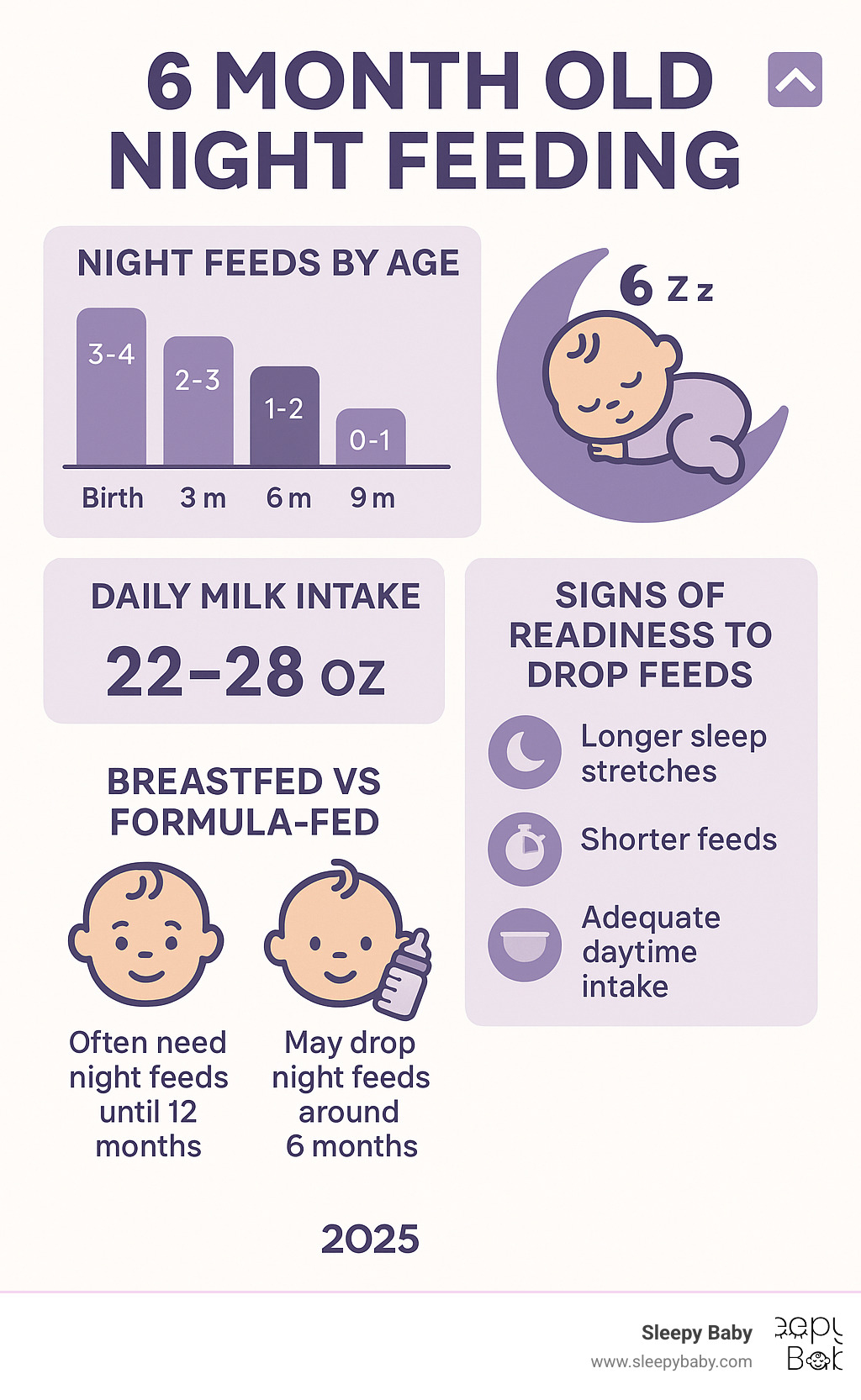
6 Month Old Night Feeding: What's Normal and What's Not
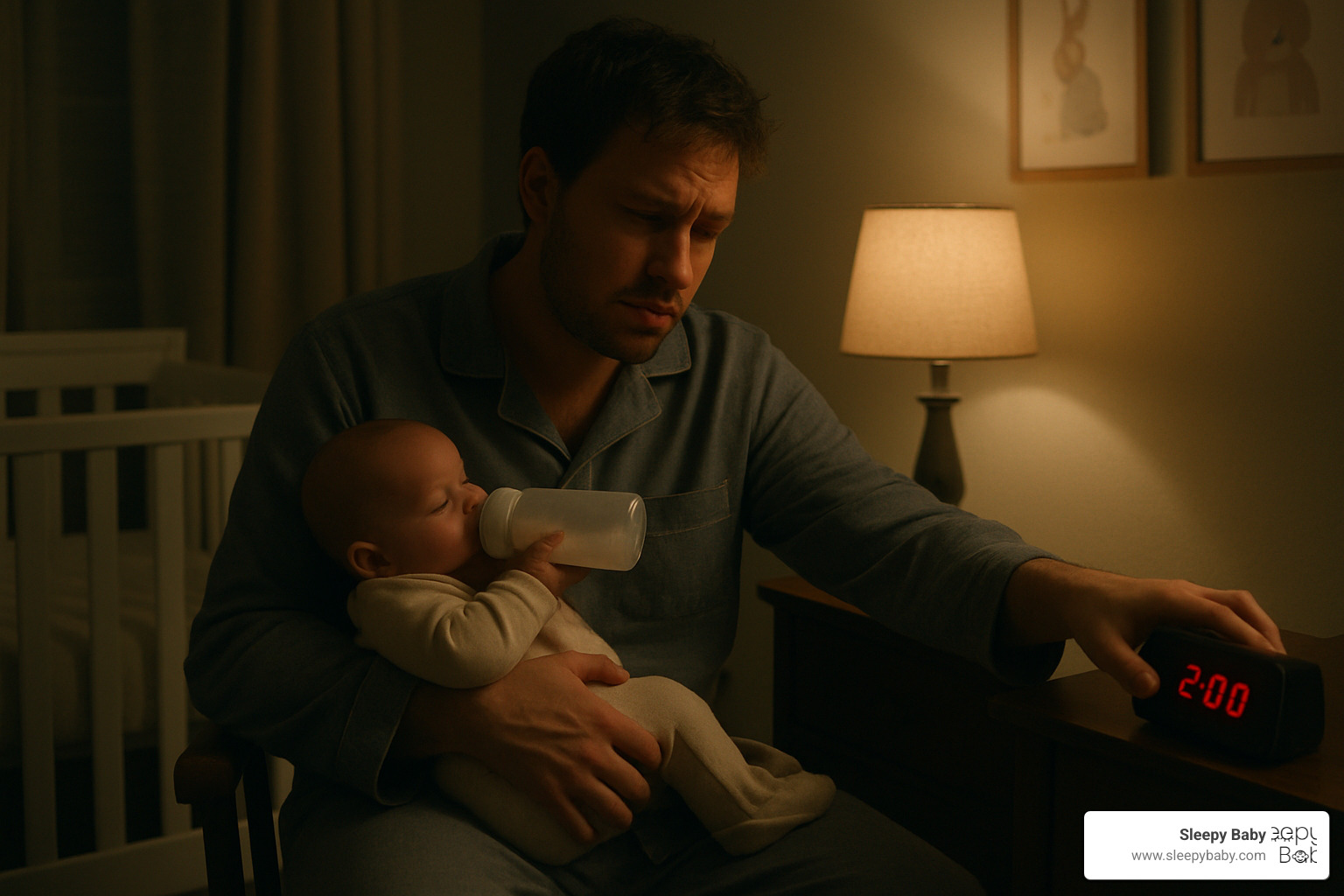
If you're wondering whether those 2am wake-ups are still normal, you're not alone. At 6 months, your baby has crossed important developmental milestones that change everything about 6 month old night feeding.
Your little one's digestive system can now process larger volumes of milk and go longer stretches without needing midnight snacks. Most babies at this age weigh between 12-13 pounds, which is the threshold where their bodies can physiologically handle 6-8 hour sleep stretches.
Scientific research on infant sleep patterns shows that most 6-month-olds need about 22-28 ounces of breast milk or formula per day, typically spread across 4-6 feeds. This is a huge shift from those newborn days when your baby needed to eat every 2-3 hours around the clock.
Breastfed and formula-fed babies follow different timelines. Formula takes more energy to digest, so formula-fed babies often drop night feeds earlier, sometimes right around 6 months. Breastfed babies may continue needing 1-2 night feeds until they're closer to 12 months old.
Growth spurts typically hit around 6 months and can temporarily increase night wakings for 2-3 days. During these periods, your baby genuinely needs those extra calories to fuel their rapid development.
How many night feeds does a 6 month old need?
The sweet spot for 6 month old night feeding is typically 1-2 wakings per night. Many babies this age can achieve their first 6-8 hour sleep stretch, especially if they're getting adequate calories during the day.
If your baby needs 22-28 ounces of milk per day and they're getting most calories during daytime hours, they may only need one night feed. This is often an early morning feed between 3-5am that can stick around until around 12 months.
Some babies naturally consolidate their sleep and drop night feeds on their own. Others may wake out of habit rather than true hunger. If your baby is taking very short feeds - under 5 minutes for breastfeeding or less than 2 ounces for bottle feeding - this often indicates habit rather than genuine hunger.
Should you wake a 6 month old to feed at night?
Unless your pediatrician has specifically told you to wake your baby due to weight gain concerns, there's typically no need to wake a 6-month-old for night feeds. By this age, most babies who are growing well can regulate their own feeding schedule.
Some parents find success with the "dream feed" - a feeding given while the baby is still sleepy, usually around 10-11pm before parents go to bed. This can help extend your baby's first sleep stretch and give everyone more rest.
Readiness Signs & Hunger-vs-Habit Checklist
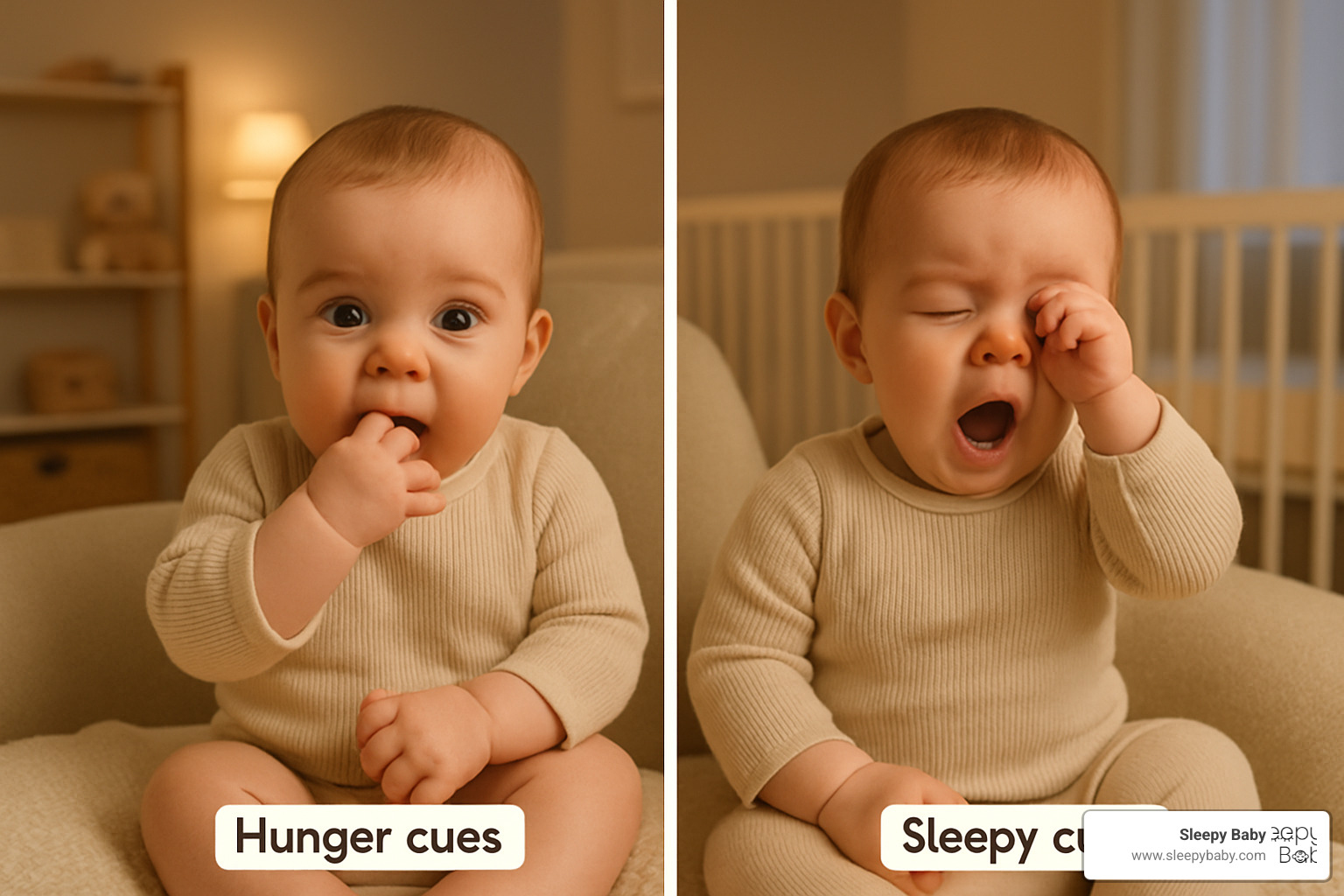
Figuring out when your baby is ready to reduce 6 month old night feeding sessions can feel like detective work. One night they're sleeping for eight hours straight, and the next they're up every two hours again. The key is looking for patterns over several days rather than judging based on one good or bad night.
Your baby's body will give you clues when they're ready for fewer night feeds. Sleep consolidation is often the first sign - you might notice they occasionally sleep for longer stretches without waking. These glimpses of longer sleep show their body can go without food for extended periods.
Another telltale sign is when night feeds become quick and inefficient. If your breastfed baby used to nurse for 15-20 minutes but now barely feeds for 5 minutes, they're likely seeking comfort rather than calories. Similarly, bottle-fed babies who used to drain 3-4 ounces might start taking just an ounce or two.
Pay attention to your baby's daytime eating patterns too. As they become more interested in solid foods and take larger daytime feeds, they naturally need fewer calories at night. Their diaper output is another reliable indicator - if they're having plenty of wet diapers and gaining weight well, they're getting adequate nutrition during the day.
Some babies start showing self-soothing attempts around this time. You might notice them reaching for a pacifier when they wake up, or making brief fussing sounds before settling back down on their own. These are encouraging signs that they're developing independent sleep skills.
Signs your baby is ready to drop night feeds
The transition away from night feeds happens gradually, and your baby will show you they're ready through subtle changes in their behavior. Longer sleep stretches are often the first clue - even if it only happens once or twice a week initially, it demonstrates their body's ability to go longer without food.
Reduced feeding intensity during night wakings is another clear sign. You'll notice less active sucking and swallowing, and your baby might seem drowsy or distracted throughout the feed. They may even fall asleep after just a few minutes of nursing or a small amount of bottle feeding.
Increased daytime appetite often accompanies readiness to drop night feeds. Your baby might nurse more frequently during the day or show more enthusiasm for solid foods. This natural shift in calorie intake from night to day is exactly what you want to see.
Comfort-seeking behaviors become more apparent too. Your baby might wake up but seem content to be soothed with gentle patting or quiet shushing rather than immediately needing food. They may also start reaching for comfort objects like a pacifier or soft toy when they wake.
Is baby waking from hunger or habit?
This is the million-dollar question that keeps many parents guessing. The difference between hunger and habit isn't always obvious, but there are reliable ways to tell them apart during 6 month old night feeding situations.
True hunger shows up as active, purposeful feeding. Your baby will latch well and feed rhythmically, taking a substantial amount - typically 5+ minutes of nursing or 2+ ounces from a bottle. They'll settle back to sleep easily afterward and seem satisfied.
Habit wakings look quite different. The feeding is brief and half-hearted, with your baby seeming drowsy throughout. They might wake at very predictable times - like clockwork every three hours - regardless of when they last ate. Sometimes they're easily distracted during the feed or seem more interested in the comfort of being held than actually eating.
Try the pause-and-wait technique when your baby wakes. Wait 5-10 minutes before going to them - sometimes they'll settle back to sleep on their own. If they continue crying, try soothing without feeding first. Offer gentle patting, quiet shushing, or a pacifier to see if comfort alone helps them settle.
Tracking feeding patterns for a few days can reveal helpful insights. Note the times your baby wakes, how much they eat, and how easily they settle back down. If you see a pattern of very brief feeds followed by easy settling, you're likely dealing with habit rather than hunger.
Consider the timing of wakings too. If your baby consistently wakes at the same times each night regardless of their last feed, this suggests a sleep association rather than genuine hunger. True hunger tends to be more variable, depending on how much they ate during the day and their individual growth needs.
For more guidance on optimizing your baby's overall sleep patterns, check out our comprehensive guide on mastering the 6-month-old sleep schedule and understanding the 6-month-old nap length sweet spot.
Step-by-Step Guide to Weaning Night Feeds

Successfully weaning 6 month old night feeding requires a gradual approach that respects your baby's needs while gently shifting their calorie intake to daytime hours. The key is patience and consistency - most babies need 1-3 weeks to fully adjust to new feeding patterns.
Start by ensuring your baby gets adequate calories during the day. For breastfed babies, this might mean offering feeds every 2.5-3.5 hours during waking hours. For formula-fed babies, ensure they're getting their full daily requirement of 22-28 ounces spread across daytime feeds.
Consider cluster feeding in the evening - offering feeds closer together between 5-8pm can help your baby take in more calories before bedtime. Some parents also find success with a dream feed around 10-11pm, which can extend the first sleep stretch.
When you're ready to reduce night feeds, tackle one feeding at a time. If your baby typically wakes twice, start with the earlier feed (around 11pm-1am) and gradually reduce it before moving to the later feed (3-5am). This approach is less disruptive to both baby and parents.
Gradual reduction method (breastfeeding)
For breastfed babies, reduce nursing time by 2-3 minutes every other night. If your baby typically nurses for 15 minutes, reduce to 12-13 minutes for two nights, then 10 minutes for two nights, and so on.
Start with shortening the time on the second breast if you typically offer both sides. Many babies will take their main nutrition from the first breast, so reducing the second side first is often easier.
When you've reduced a feed to about 5 minutes or less, try offering comfort instead of nursing when your baby wakes. Use gentle patting, shushing, or a pacifier to help them settle back to sleep.
To protect your milk supply during this process, consider pumping once before bedtime or adding an extra daytime nursing session. Monitor your baby's diaper output and weight gain to ensure they're getting adequate nutrition.
Gradual reduction method (formula)
For formula-fed babies, reduce the volume of night bottles by 1 ounce every 2-3 nights. If your baby typically takes a 4-ounce bottle, reduce to 3 ounces for a few nights, then 2 ounces, and so on.
Once you've reduced a bottle to 2 ounces or less, you can try offering water instead, though many babies will refuse this and settle back to sleep with other comfort measures.
When reducing bottle volumes, make sure your baby is getting their full daily requirement during daytime hours. You may need to increase daytime bottle sizes slightly or add an extra feed to compensate.
Bringing in other soothing methods
As you reduce 6 month old night feeding, having alternative soothing methods becomes crucial. This is where tools like our Sleepy Baby devices can be invaluable - the rhythmic patting and white noise can provide the comfort your baby previously got from feeding.
Other effective soothing methods include:
White noise: Consistent background sound can help mask household noises and provide comfort during sleep transitions.
Gentle patting or rubbing: Light, rhythmic touch on your baby's back or tummy can be very soothing. Our Sleepy Baby devices are designed to provide this consistent, gentle motion.
Pacifier: If your baby takes one, a pacifier can satisfy their sucking needs without providing calories.
Caregiver rotation: Sometimes having your partner attend to night wakings can help break the association between you and feeding, especially for breastfed babies.
The key is consistency - once you choose a soothing method, stick with it for at least a week before deciding if it's working.
Troubleshooting & Special Situations

Even the best 6 month old night feeding weaning plans can hit roadblocks. One night your baby seems ready to drop feeds, and the next they're waking up crying every two hours. This is completely normal.
Teething is probably the biggest culprit around 6 months. When those little teeth start pushing through tender gums, your previously cooperative baby might suddenly need extra comfort at night. During these rough patches, it's perfectly okay to pause your night weaning efforts and focus on helping your baby feel comfortable.
Illness is another time to pause weaning. A congested or feverish baby needs extra fluids and comfort, not sleep training. Growth spurts can also temporarily derail your plans, as babies often go through a significant growth spurt around 6 months that increases their calorie needs.
Sleep regressions are another common challenge. The 6-month sleep regression often coincides with new skills like sitting up or crawling, disrupting sleep patterns for 2-4 weeks.
When baby resists dropping feeds
If your baby is fighting the night weaning process, take a deep breath. You're not doing anything wrong - some babies just need more time to adjust.
Slow down the timeline if you've been reducing feeds every few nights. Some babies need changes every 4-5 nights instead of every 2-3 nights. There's no prize for finishing fastest.
Double-check daytime intake to ensure your baby is getting enough calories during waking hours. Consider adding an extra daytime feed or increasing bottle sizes slightly.
Bring in your partner for some night wakings. Babies often settle more easily for someone who doesn't smell like milk, especially for breastfed babies.
Will night weaning hurt milk supply?
Your milk supply operates on supply and demand, so reducing night feeds can potentially impact production. However, most mothers can maintain adequate supply with thoughtful adjustments.
Adding a daytime nursing session or pumping session can help replace the calories your baby would have gotten at night. Many mothers find that a quick pump before bedtime helps maintain supply.
Watch your baby's diaper output as a key indicator. Four to six wet diapers per day means they're getting enough milk. Regular weight checks with your pediatrician will confirm whether your baby is getting adequate nutrition.
Can night weaning and sleep training overlap?
Many families successfully combine night weaning with sleep training using the "core night method" - designating certain hours as feeding-free zones while still allowing feeds outside these hours.
Consistency becomes crucial when combining these approaches. Once you decide not to feed during a particular waking, stick with your chosen soothing method.
This is where our Sleepy Baby devices really shine. The rhythmic patting and white noise provide consistent, hands-free soothing that doesn't require your physical presence. Your baby can learn to associate these comforting sensations with sleep rather than feeding.
For more comprehensive strategies on managing sleep challenges, our guide to baby sleep solutions offers additional techniques that work well alongside night weaning efforts.
Frequently Asked Questions about Night Weaning
Are there risks to stopping night feeds too early?
Yes - rushing into night weaning before your baby is ready can impact their growth and development. While 6 months is often considered the sweet spot for beginning 6 month old night feeding reduction, every baby develops at their own pace.
Babies under 4 months typically still need regular night nutrition to support their rapid growth. Even at 6 months, some little ones aren't quite ready - especially those who were born prematurely or have lower birth weights.
Watch for these signs that your baby might not be ready yet: poor weight gain, fewer than 4 wet diapers per day, or seeming genuinely hungry during night feeds with active sucking. The magic number many pediatricians look for is 12-13 pounds - this weight threshold often indicates a baby can physiologically go longer stretches without food.
What if my baby is breastfed and still wakes every 2 hours?
Frequent night wakings in breastfed babies can be particularly exhausting. Around 4-6 months, many breastfed babies go through the "world is too interesting" phase, becoming easily distracted during daytime feeds. When they don't get enough calories during the day, they naturally make up for it at night.
Try creating a calm feeding environment during the day - dim the lights, find a quiet room, and minimize distractions. You might need to offer feeds more frequently during waking hours, about every 2.5-3 hours.
Some breastfed babies continue needing 1-2 night feeds until closer to 12 months, and this is completely normal. Breast milk is digested more quickly than formula, so these little ones often need that extra nutrition longer.
When should I call the pediatrician about night feeding?
Trust your gut - if something feels off, it's always worth a conversation with your pediatrician.
Definitely reach out if your baby is losing weight or not gaining appropriately, if wet diaper output decreases to fewer than 4 per day, or if you notice changes in your baby's behavior like lethargy or unusual fussiness.
For breastfeeding mothers, concerns about milk supply are valid reasons to seek guidance. Babies with special circumstances - those born prematurely, with medical conditions, or who have had feeding difficulties - often need individualized approaches to night weaning.
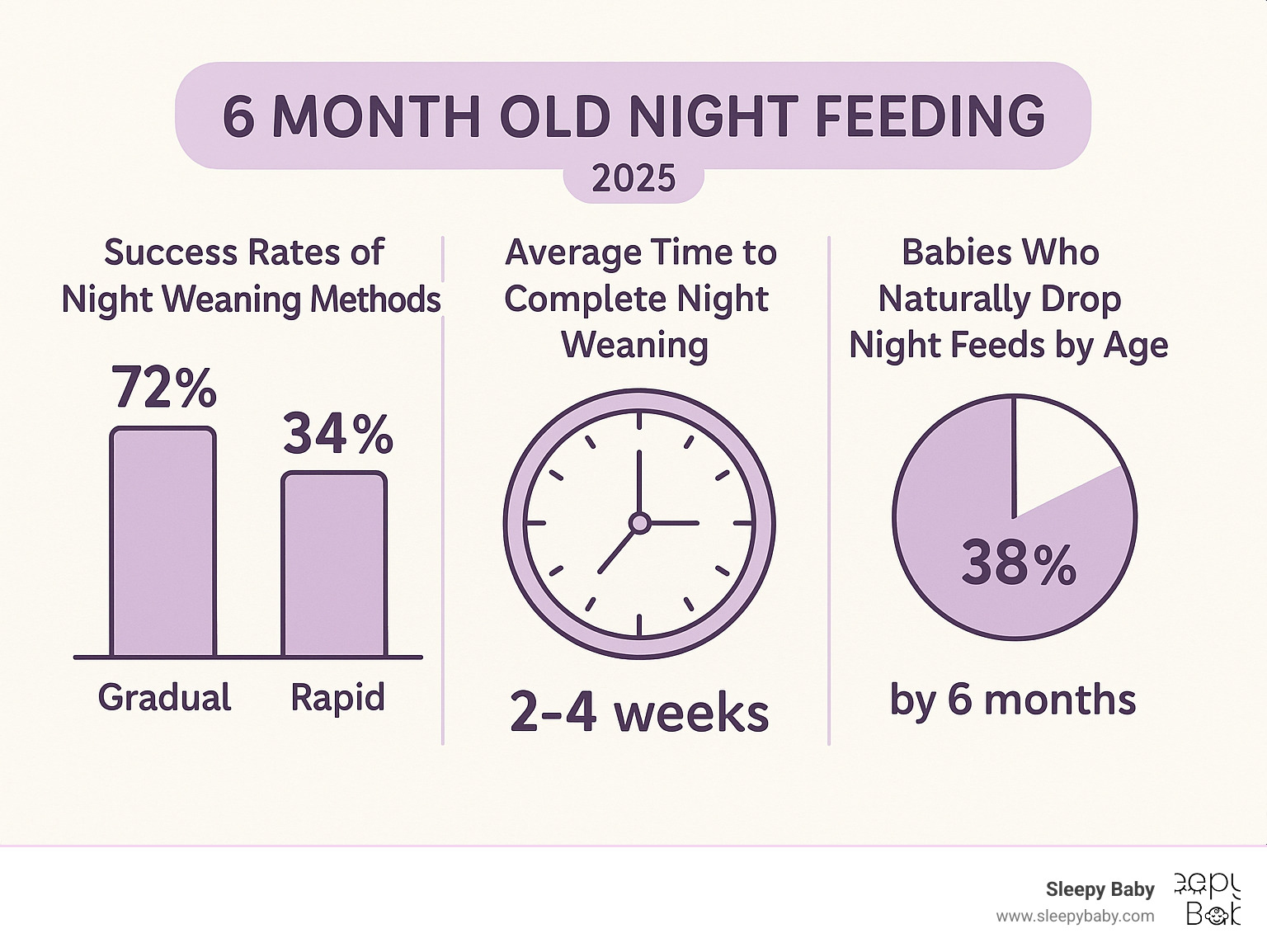
Conclusion
Successfully navigating 6 month old night feeding transitions is one of those parenting milestones that feels both exciting and daunting. You're probably eager for longer stretches of sleep, but also wondering if you're doing the right thing for your baby.
Here's the truth: every baby is different. Some little ones will naturally drop night feeds around 6 months like they've read the parenting books. Others - especially breastfed babies - may need that cozy 3am snuggle and feed until closer to their first birthday. And that's perfectly normal.
The most important thing is reading your baby's cues and responding with patience. If they're showing clear signs of readiness - sleeping longer stretches naturally, taking shorter feeds at night, or eating well during the day - you can confidently begin the gradual process of reducing night feeds. But if they resist or seem genuinely hungry, there's no shame in slowing down or waiting a few more weeks.
Throughout this journey, having reliable soothing alternatives becomes your secret weapon. This is where our Sleepy Baby devices truly shine. When you're reducing feeds, your baby still needs comfort - they just don't need the calories. Our devices provide that rhythmic patting and white noise that mimics your loving touch, giving your little one the comfort they crave without requiring you to be physically present at every waking.
The hands-free design means you can provide consistent soothing even when you're exhausted from broken sleep. No more standing over the crib patting your baby's back until your arm goes numb! Our portable sleep aids travel with you, ensuring your baby gets the same comforting experience whether they're in their crib at home or visiting grandparents.
This phase is temporary. With patience, consistency, and the right approach, most babies can learn to sleep for longer stretches. Some nights will be harder than others, but you're not just helping your baby sleep better - you're teaching them an important life skill of self-soothing.
Ready to take the next step in your baby's sleep journey? Check out our comprehensive guide to Mastering the 6-Month-Old Sleep Schedule for more strategies to help your little one (and you) get the rest you deserve.
For additional support with daytime sleep, don't miss our insights on the 6-month-old nap length sweet spot to ensure your daytime sleep schedule supports successful night weaning.
Sweet dreams are ahead - you've got this!


